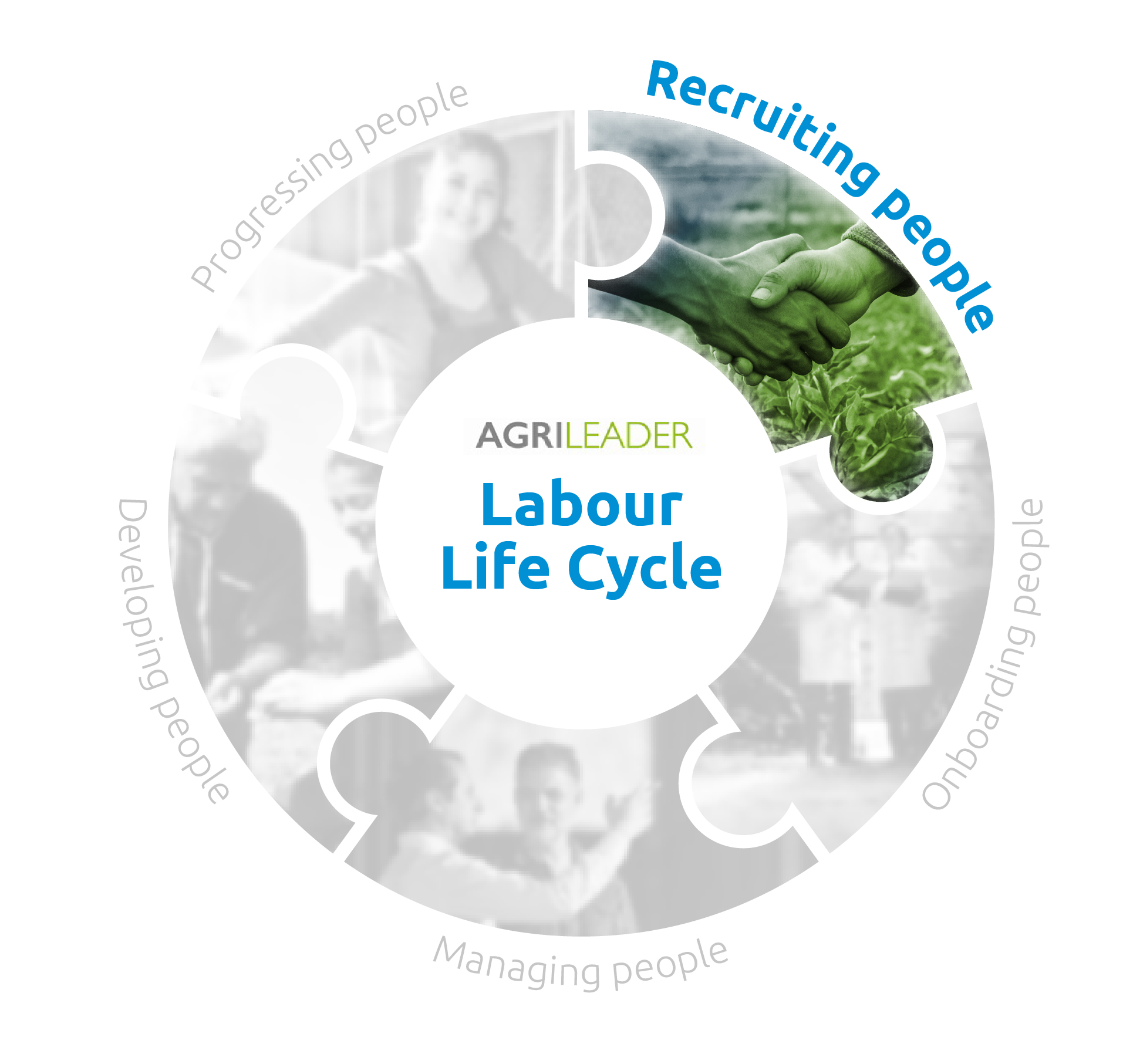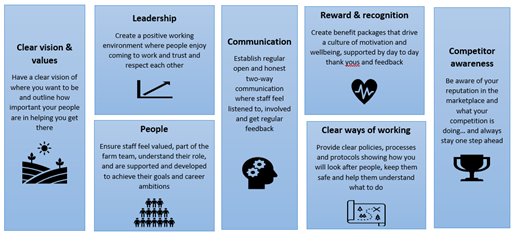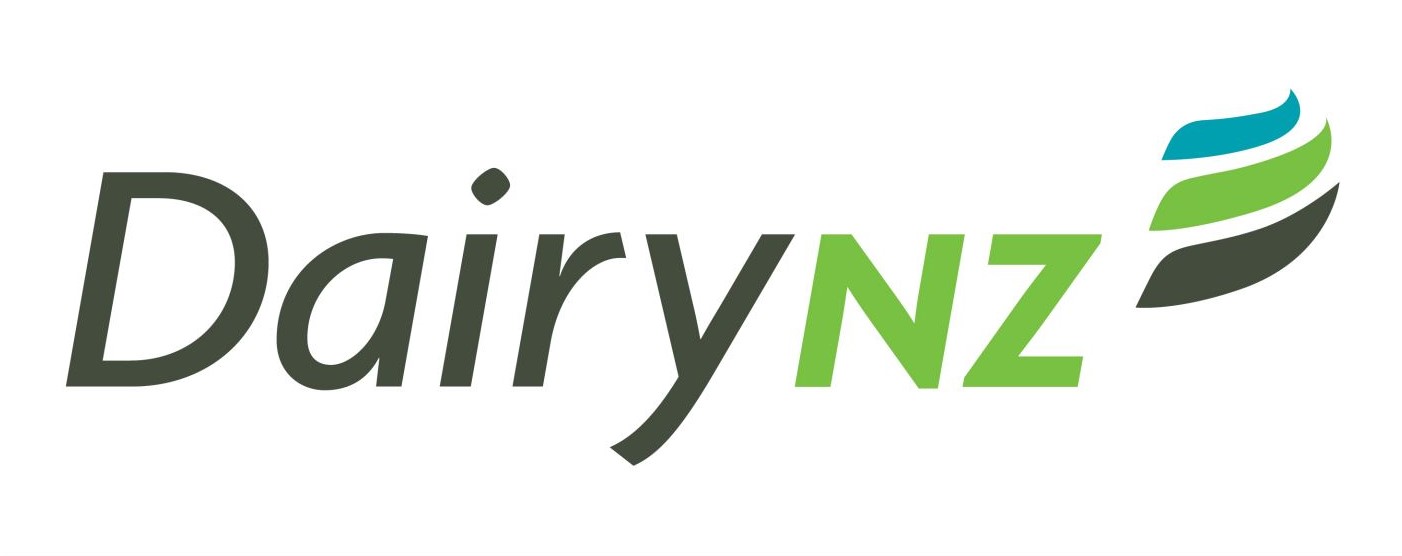- Home
- Recruiting people
Recruiting people
Make your recruitment process as efficient as possible – learn how to become an employer of choice, write an effective job advert, conduct successful interviews, and more.
Back to: Labour life cycle in agriculture
An organised recruitment process saves time and money and reflects well on your business. Ensure it goes smoothly by having basics in place: knowing the difference between job adverts and job descriptions, running an interview and making recruitment decisions.
Be an employer of choice
An employer of choice is a business that people want to work for. If your business is known as a popular workplace that values its staff, you will stand out from the competition in the job market. When you’re recruiting, it’s important to show exactly why someone would want to work for you. Use our building blocks and the resources below to learn more about becoming an employer of choice.

Seven building blocks for becoming an employer of choice

- Clear vision and values: Have a clear vision of where you want to be and outline how important your people are in helping you get there.
- People: Ensure staff feel valued and part of the team, understand their role and are supported and developed to achieve their goals and career ambitions.
- Communication: Establish regular, honest, two-way communication where staff feel listened to and involved and get regular feedback.
- Reward and recognition: Create benefit packages that drive a culture of motivation and wellbeing, supported by day-to-day thank yous and feedback.
- Clear ways of working: Provide clear policies, processes and protocols showing how you will look after people, keep them safe and help them understand what to do.
- Competitor awareness: Be aware of your reputation in the marketplace and what your competition is doing, and always stay one step ahead. Do also consider other employment areas, such as pensions, payroll and liability insurance.
Define your HR policies and procedures
HR policies and procedures provide a common understanding of how you recruit, manage and take care of your people. They help to set clear boundaries, prevent misunderstandings, save time and money, and ultimately protect your business.
Five business benefits of good HR policies:
-
Increased productivity – ensures everyone is on the same page, reducing downtime, and increasing motivation and productivity.
-
Saving time and money – onboarding new employees more quickly, building their confidence and reducing unnecessary worry or confusion.
-
Preventing problems – written guidance that describes acceptable and unacceptable ways of working and avoids people making assumptions that often lead to mistakes or re-doing work.
-
Reduced risk – protect the business against legal claims and avoid involvement in employment tribunals by providing guidance that reflects legislation.
-
Improved reputation – enhances your reputation as an employer of choice and your ability to attract and retain the best people.
Review your policies regularly to make sure they are current, practical and usable.
Useful links
The links below will help you build a set of HR policies to suit your business. You should seek out legal advice before finalising any of your internal HR policies and procedures.
Recruitment and development
- Recruitment and selection
- Performance management: induction, probation, appraisal, performance review and reward
- Training and development
Hours and leave
- Holiday entitlement on gov.uk
- Sickness and absence
- Flexible working on ACAS site
- Maternity, paternity, adoption and parental leave
Health and safety policy
Other considerations
Be an inclusive employer
Inclusive workplaces often benefit from higher staff morale and retention, as well as greater productivity. Use the links below to find out more about creating a more inclusive work environment for your business.
Note that the Equality and Human Rights Commission recommends that employers monitor applications so they can promote equal opportunities in the workplace.

Writing a job advert
When you write a job advert, it needs to appeal to the sort of person you would want to employ. Think carefully about what you will include in it, from the specifics of the job title to key responsibilities to expected working hours.
How do I write a great job advert?
The aim of the advert is to attract appropriately skilled people. Research shows that a greater level of detail is desirable as it allows the person viewing the advert to more accurately self-select for the role – which means they will only apply if they think they are suited to the role. See the box for the kind of information you should include when writing your job advert.
Job title: descriptive of the job role or something catchy to attract applicants’ attention.
Position type: permanent, full-time, casual, etc.
Job description: summary of the key responsibilities of the role.
Person specification: summary of the knowledge, skills, experience and attitude that would suit the role.
Region: location of the role.
Start date: the date you require the successful candidate to start their new role.
Closing date: the date applications close.
Hours of work: describe the expected hours, ideally by season.
Expected roster: this indicates the time off.
Remuneration: preferred but not essential, but it does give applicants an idea of whether the pay is close to their requirements. This could be advertised with an indication of the salary range, with the final amount determined by the level of skill and experience.
Job benefits: describe any non-cash benefits and highlight any opportunities the role offers (e.g. training, proximity to town, recreational activities, local schooling, leave provisions, the on-farm team, etc).
Farm information: give a brief outline of the farm – where it is, size, type or number of livestock, facilities, number of staff on farm.
Accommodation provided: a summary of any accommodation provided.
Contact details:
- Contact name (yourself or a colleague)
- Contact method (phone number, email and/or written address)
- How people can apply (CV, cover letter etc)
Ways to advertise
You can publicise your farm role through:
- Word of mouth and referrals through friends and colleagues
- Local newspapers and magazines
- Approaching potential applicants directly (but always do so professionally and respectfully)
- Noticeboards and newsletters: colleges, schools, universities, parishes, local clubs, etc
- Ex armed forces
- Through a farm consultant or agricultural recruitment agency
- Social media
More tips
Always present your organisation to a high standard. The job market is competitive, and everyone is chasing the same talent, so being organised and professional will give you the edge. Don’t oversell the role, as this could lead to disappointment and poor performance and staff retention. (It is also illegal under the Fair Trading Act.) Be readily contactable by whatever means you specified in your advert.
Respond to queries promptly. This shows you are managing your time well and will put you in a positive light to potential employees.
Writing a job description
A job description is a summary of the key responsibilities and duties of the job, as well as the employer’s expectations about how the job will be performed. It’s a legal requirement to provide one when you’re hiring new people, and it includes more specific details about the day-to-day role than a job advert.
A job description helps you:
- Ensure the right applicants apply for your job
- Get employees to perform well because they know what is expected of them
- Make employees easier to manage, resulting in less stress
- Keep employees happier because they can choose a job that suits them, and they know what they are supposed to do
What goes into a job description?
- Job title
- Purpose of the job
- A two to three sentence summary of the role
- Who the job reports to/any reports the job has
- Tasks, duties and responsibility areas for fulfilling the job requirements. Usually, these will cover 7 to 10 responsibility areas, for example:
- Harvesting
- Stock management
- Animal health and welfare
- Seasonal management requirements
- Recording
- Environmental management
- Team responsibilities
- Health and safety
- Maintaining a tidy workplace
Tips for using your job description
Include the job description in the advert, so applicants can see whether the role is a good fit for them.
Keep job descriptions on file to revise and reuse. They can also be used as a management tool going forward. When you have developed a job description, you can also use it to:
- Help you write job adverts
- Develop competency-based interview questions
- Help during new employee orientation
- Identify performance objectives and training requirements, and assist with terminations
Managing interviews
The interview stage is where you’ll really get a feel for whether a person will be a good addition to your on-farm team. Use the links to see tips on how to choose good candidates from your pool of applicants, what kind of questions to ask at an interview, and how to check references and offer someone a job.
Before: Choosing your candidates
During: How to conduct an interview
After: Making a job offer
Consider apprenticeships
Don’t forget that apprenticeships can be valuable in the farming and growing industries when you’re looking for additional employees. There’s more information on our Trailblazer Apprenticeships page, including our webinar on how to make the most of an apprenticeship.
Useful links
Learn how to manage a team of employees
DairyNZ has kindly given permission for AHDB to adapt their ‘People’ resources for use by the British dairy industry. We share a commitment to supporting dairy industry and will collaborate to provide benefit to New Zealand’s and British dairy farmers.





